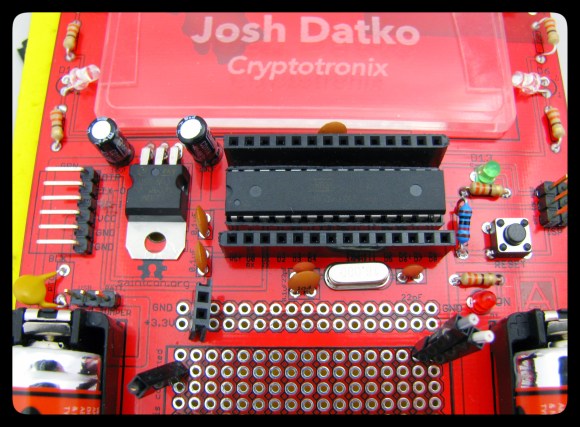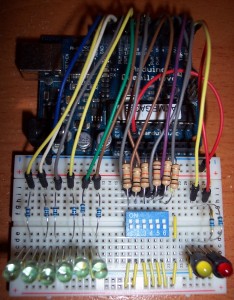When I posted the “LED Control Using DIP Switch” sketch last year (a simple setup the turned on the LED corresponding to that switch position), I also had a slightly modified version of it in which the DIP switch controlled six different light patterns on the LEDs (scroll right, left, in, out, back and forth and random). It presented a “cleaned-up” version of the code using for loops and compared it to the “long-hand” version, showing the trade-off between ease of understanding and conciseness. Except that… I forgot to post it.
Last week someone contacted me asking a question about a similar project he is working on and when I wanted to refer him to this modified sketch I realized it wasn’t on the blog. (Here’s the original sketch and schematic for reference).
What follows below is the missing blog post (not anymore), a comparison between the more readable sketch (easier for beginners to understand) and the more concise version, in a series of snippets showing the main differences between the two versions of the sketch.
The concise version generates a binary sketch that occupies approximately 25% less memory and is almost half as long in lines of code. The entire source code listings are at the very bottom of this post.
Note: the line above each snippet reflects the modification that shortened the sketch.
1) not using #define directives for the LED and switch pins on the Arduino in order to use for loops:
} else {
// default: off
digitalWrite(LED1, LOW);
digitalWrite(LED2, LOW);
digitalWrite(LED3, LOW);
digitalWrite(LED4, LOW);
digitalWrite(LED5, LOW);
digitalWrite(LED6, LOW);
}
|
} else {
// default: off
for (i = 13; i >= 8; i--) {
digitalWrite(i, LOW);
}
|
2) using a state variable array (and consequently a for loop) as opposed to individual state variables:
s1state = digitalRead(S1);
s2state = digitalRead(S2);
s3state = digitalRead(S3);
s4state = digitalRead(S4);
s5state = digitalRead(S5);
s6state = digitalRead(S6);
|
for (i = 0, j = 7; i < 6, j >= 2; i++, j--) {
state[i] = digitalRead(j);
}
|
3) if (x) versus if (x == 1) (when x is either 0 or 1, then the (x == 1) expression can be written as simply (x)):
} else if (s5state == 1) {
// scroll back and forth
|
} else if (state[4]) {
// scroll back and forth
|
4) long, repetitive code to randomly turn on or not each LED (for a random duration up to 300 milliseconds) replaced with for loop:
} else if (s6state == 1) {
// random
randomSeed(analogRead(3));
onoroff = random(0, 2);
millisecs = random(0, 301);
digitalWrite(LED1, onoroff);
delay(millisecs);
randomSeed(analogRead(3));
onoroff = random(0, 2);
millisecs = random(0, 301);
digitalWrite(LED2, onoroff);
delay(millisecs);
randomSeed(analogRead(3));
onoroff = random(0, 2);
millisecs = random(0, 301);
digitalWrite(LED3, onoroff);
delay(millisecs);
randomSeed(analogRead(3));
onoroff = random(0, 2);
millisecs = random(0, 301);
digitalWrite(LED4, onoroff);
delay(millisecs);
randomSeed(analogRead(3));
onoroff = random(0, 2);
millisecs = random(0, 301);
digitalWrite(LED5, onoroff);
delay(millisecs);
randomSeed(analogRead(3));
onoroff = random(0, 2);
millisecs = random(0, 301);
digitalWrite(LED6, onoroff);
delay(millisecs);
}
|
} else if (state[5]) {
// random
for (i = 13; i >= 8; i--) {
randomSeed(analogRead(i - 8));
onoroff = random(0, 2);
millisecs = random(0, 301);
digitalWrite(i, onoroff);
delay(millisecs);
}
}
|
Here’s the full long version:
- Binary sketch size: 3654 bytes
- Code size was sacrificed in order to improve readability for beginners
- Sketch length: 205 lines
// www.TinkerHobby.com
// Natalia Fargasch Norman
// LED control via DIP switches
// Arduino pins used for the LEDs
#define LED1 13
#define LED2 12
#define LED3 11
#define LED4 10
#define LED5 9
#define LED6 8
// Arduino pins used for the switches
#define S1 7
#define S2 6
#define S3 5
#define S4 4
#define S5 3
#define S6 2
// State of each switch (0 or 1)
int s1state;
int s2state;
int s3state;
int s4state;
int s5state;
int s6state;
// Random values for LED state and delay
long onoroff;
long millisecs;
void setup() {
// pins for LEDs are outputs
pinMode(LED1, OUTPUT);
pinMode(LED2, OUTPUT);
pinMode(LED3, OUTPUT);
pinMode(LED4, OUTPUT);
pinMode(LED5, OUTPUT);
pinMode(LED6, OUTPUT);
// pins for switches are inputs
pinMode(S1, INPUT);
pinMode(S2, INPUT);
pinMode(S3, INPUT);
pinMode(S4, INPUT);
pinMode(S5, INPUT);
pinMode(S6, INPUT);
}
void loop() {
s1state = digitalRead(S1);
s2state = digitalRead(S2);
s3state = digitalRead(S3);
s4state = digitalRead(S4);
s5state = digitalRead(S5);
s6state = digitalRead(S6);
if (s1state == 1) {
// scroll right
digitalWrite(LED1, HIGH);
delay(250);
digitalWrite(LED1, LOW);
digitalWrite(LED2, HIGH);
delay(250);
digitalWrite(LED2, LOW);
digitalWrite(LED3, HIGH);
delay(250);
digitalWrite(LED3, LOW);
digitalWrite(LED4, HIGH);
delay(250);
digitalWrite(LED4, LOW);
digitalWrite(LED5, HIGH);
delay(250);
digitalWrite(LED5, LOW);
digitalWrite(LED6, HIGH);
delay(250);
digitalWrite(LED6, LOW);
} else if (s2state == 1) {
// scroll left
digitalWrite(LED6, HIGH);
delay(250);
digitalWrite(LED6, LOW);
digitalWrite(LED5, HIGH);
delay(250);
digitalWrite(LED5, LOW);
digitalWrite(LED4, HIGH);
delay(250);
digitalWrite(LED4, LOW);
digitalWrite(LED3, HIGH);
delay(250);
digitalWrite(LED3, LOW);
digitalWrite(LED2, HIGH);
delay(250);
digitalWrite(LED2, LOW);
digitalWrite(LED1, HIGH);
delay(250);
digitalWrite(LED1, LOW);
} else if (s3state == 1) {
// scroll in
digitalWrite(LED1, HIGH);
digitalWrite(LED6, HIGH);
delay(250);
digitalWrite(LED1, LOW);
digitalWrite(LED6, LOW);
digitalWrite(LED2, HIGH);
digitalWrite(LED5, HIGH);
delay(250);
digitalWrite(LED2, LOW);
digitalWrite(LED5, LOW);
digitalWrite(LED3, HIGH);
digitalWrite(LED4, HIGH);
delay(250);
digitalWrite(LED3, LOW);
digitalWrite(LED4, LOW);
} else if (s4state == 1) {
// scroll out
digitalWrite(LED3, HIGH);
digitalWrite(LED4, HIGH);
delay(250);
digitalWrite(LED3, LOW);
digitalWrite(LED4, LOW);
digitalWrite(LED2, HIGH);
digitalWrite(LED5, HIGH);
delay(250);
digitalWrite(LED2, LOW);
digitalWrite(LED5, LOW);
digitalWrite(LED1, HIGH);
digitalWrite(LED6, HIGH);
delay(250);
digitalWrite(LED1, LOW);
digitalWrite(LED6, LOW);
} else if (s5state == 1) {
// scroll back and forth
digitalWrite(LED1, HIGH);
delay(250);
digitalWrite(LED1, LOW);
digitalWrite(LED2, HIGH);
delay(250);
digitalWrite(LED2, LOW);
digitalWrite(LED3, HIGH);
delay(250);
digitalWrite(LED3, LOW);
digitalWrite(LED4, HIGH);
delay(250);
digitalWrite(LED4, LOW);
digitalWrite(LED5, HIGH);
delay(250);
digitalWrite(LED5, LOW);
digitalWrite(LED6, HIGH);
delay(250);
digitalWrite(LED6, LOW);
digitalWrite(LED5, HIGH);
delay(250);
digitalWrite(LED5, LOW);
digitalWrite(LED4, HIGH);
delay(250);
digitalWrite(LED4, LOW);
digitalWrite(LED3, HIGH);
delay(250);
digitalWrite(LED3, LOW);
digitalWrite(LED2, HIGH);
delay(250);
digitalWrite(LED2, LOW);
} else if (s6state == 1) {
// random
randomSeed(analogRead(3));
onoroff = random(0, 2);
millisecs = random(0, 301);
digitalWrite(LED1, onoroff);
delay(millisecs);
randomSeed(analogRead(3));
onoroff = random(0, 2);
millisecs = random(0, 301);
digitalWrite(LED2, onoroff);
delay(millisecs);
randomSeed(analogRead(3));
onoroff = random(0, 2);
millisecs = random(0, 301);
digitalWrite(LED3, onoroff);
delay(millisecs);
randomSeed(analogRead(3));
onoroff = random(0, 2);
millisecs = random(0, 301);
digitalWrite(LED4, onoroff);
delay(millisecs);
randomSeed(analogRead(3));
onoroff = random(0, 2);
millisecs = random(0, 301);
digitalWrite(LED5, onoroff);
delay(millisecs);
randomSeed(analogRead(3));
onoroff = random(0, 2);
millisecs = random(0, 301);
digitalWrite(LED6, onoroff);
delay(millisecs);
} else {
// default: off
digitalWrite(LED1, LOW);
digitalWrite(LED2, LOW);
digitalWrite(LED3, LOW);
digitalWrite(LED4, LOW);
digitalWrite(LED5, LOW);
digitalWrite(LED6, LOW);
}
}
And here’s the full “cleaned-up” version:
- Binary sketch size: 2826 bytes
- Sketch length: 119 lines
// www.TinkerHobby.com
// Natalia Fargasch Norman
// LED control via DIP switches
// Arduino pins used for the LEDs
// LED1 13
// LED2 12
// LED3 11
// LED4 10
// LED5 9
// LED6 8
// Arduino pins used for the switches
// S1 7
// S2 6
// S3 5
// S4 4
// S5 3
// S6 2
// State of each switch (0 or 1)
int state[6];
// Random values for LED state and delay
long onoroff;
long millisecs;
// loop counters
int i, j;
// delay
int d = 250;
void setup() {
// pins for LEDs are outputs
// LEDs 1-6 on pins 13-8
for (i = 13; i >= 8; i--) {
pinMode(i, OUTPUT);
}
// pins for switches are inputs
// switches 1-6 on pins 7-2
for (i = 7; i >= 2; i--) {
pinMode(i, INPUT);
}
}
void loop() {
for (i = 0, j = 7; i < 6, j >= 2; i++, j--) {
state[i] = digitalRead(j);
}
if (state[0]) {
// scroll right
for (i = 13; i >= 8; i--) {
digitalWrite(i, HIGH);
delay(d);
digitalWrite(i, LOW);
}
} else if (state[1]) {
// scroll left
for (i = 8; i <= 13; i++) {
digitalWrite(i, HIGH);
delay(d);
digitalWrite(i, LOW);
}
} else if (state[2]) {
// scroll in
// light up LEDs on pins i and 8+(13-i)
for (i = 13; i >= 11; i--) {
digitalWrite(i, HIGH);
digitalWrite(21 - i, HIGH);
delay(d);
digitalWrite(i, LOW);
digitalWrite(21 - i, LOW);
}
} else if (state[3]) {
// scroll out
// light up LEDs on pins i and 8+(13-i)
for (i = 11; i <= 13; i++) {
digitalWrite(i, HIGH);
digitalWrite(21 - i, HIGH);
delay(d);
digitalWrite(i, LOW);
digitalWrite(21 - i, LOW);
}
} else if (state[4]) {
// scroll back and forth
for (i = 13; i >= 8; i--) {
digitalWrite(i, HIGH);
delay(d);
digitalWrite(i, LOW);
}
for (i = 9; i <= 12; i++) {
digitalWrite(i, HIGH);
delay(d);
digitalWrite(i, LOW);
}
} else if (state[5]) {
// random
for (i = 13; i >= 8; i--) {
randomSeed(analogRead(i - 8));
onoroff = random(0, 2);
millisecs = random(0, 301);
digitalWrite(i, onoroff);
delay(millisecs);
}
} else {
// default: off
for (i = 13; i >= 8; i--) {
digitalWrite(i, LOW);
}
}
}
Check out the video of this sketch in action.
LED Patterns Using DIP Switch and Arduino originally appeared on Tinker Hobby on November 8, 2011.







